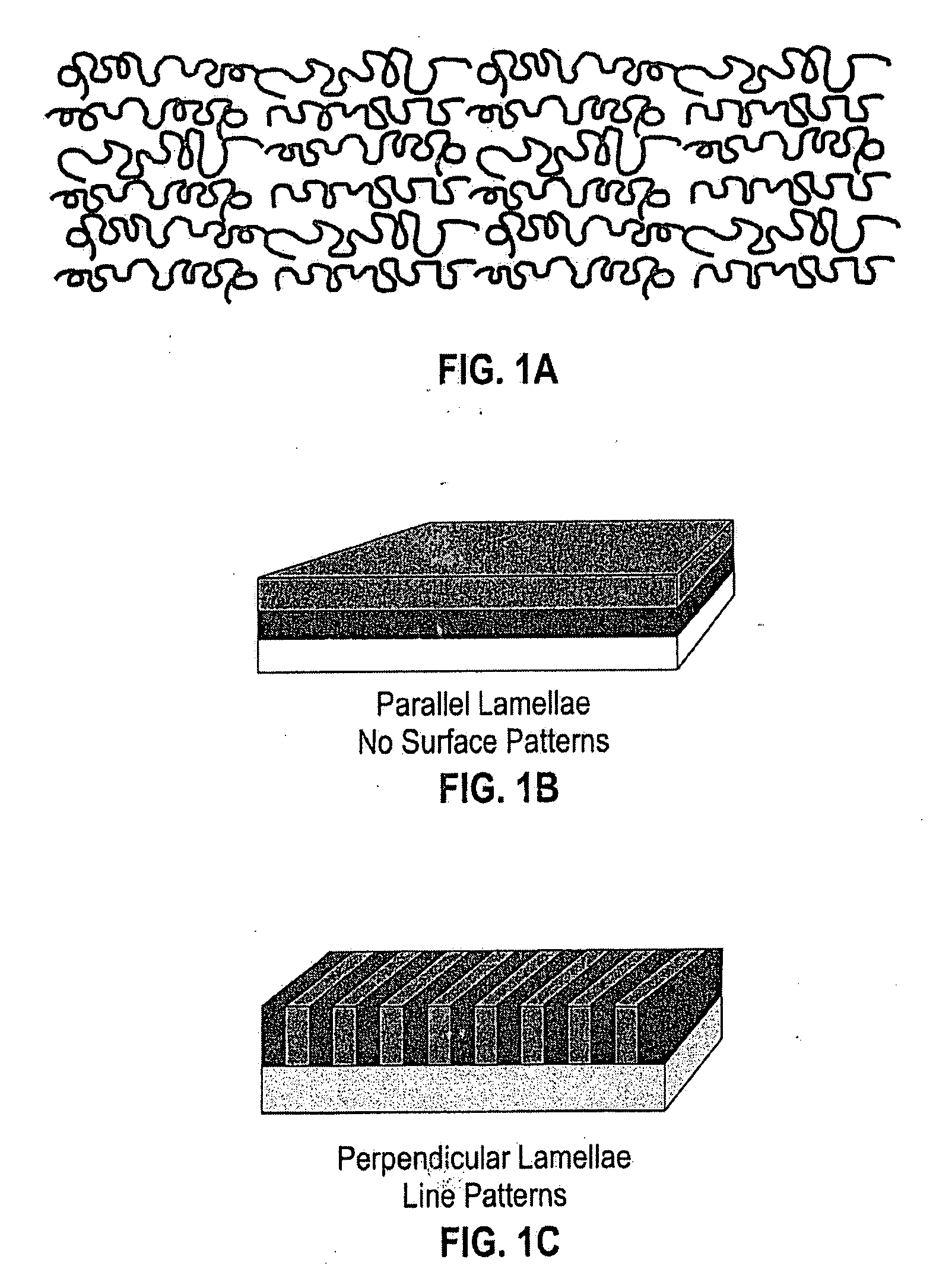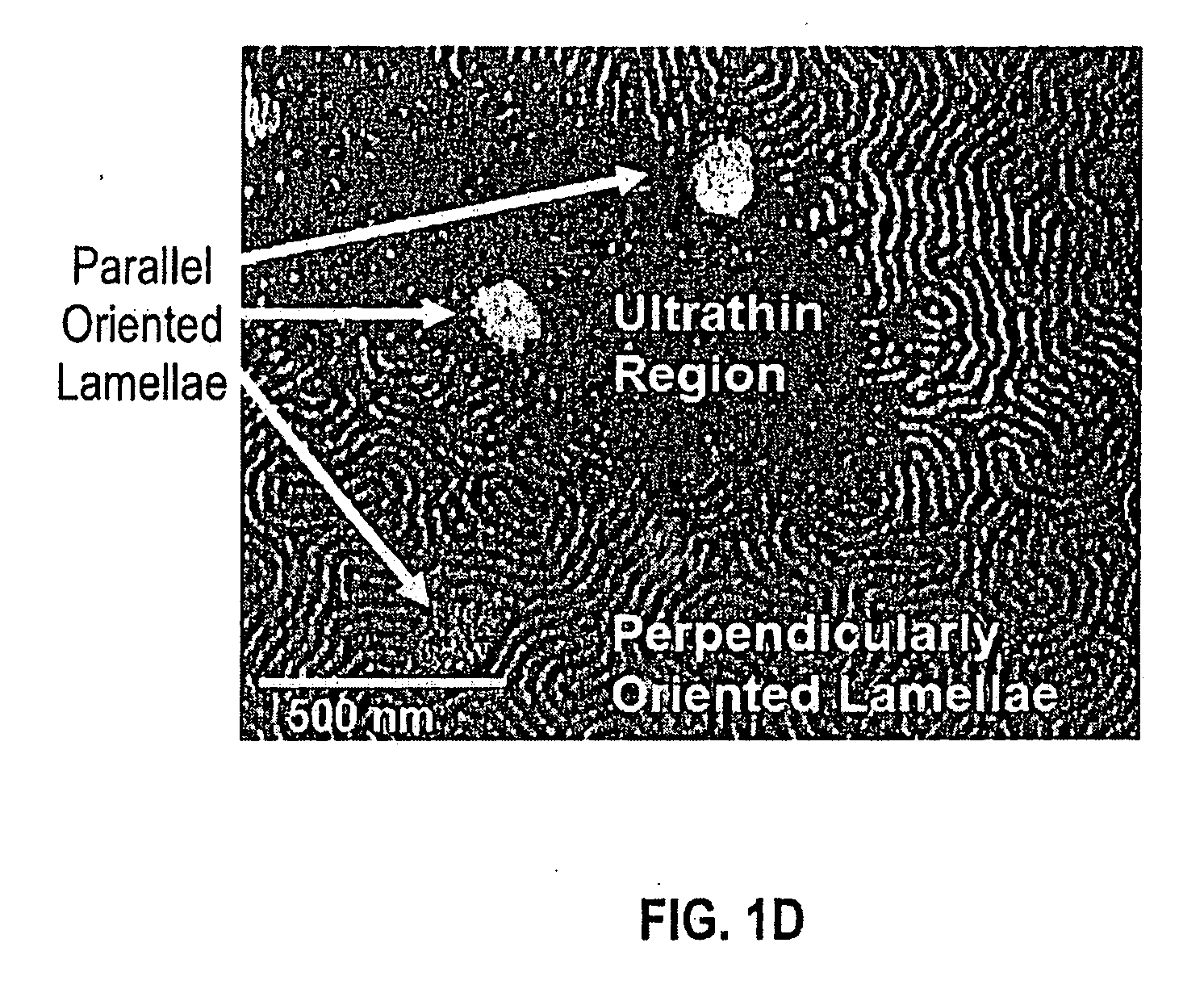Method of Controlling Orientation of Domains in Block Copolymer Films
a technology of block copolymer and domain, applied in microstructural technology, microstructural devices, nanoinformatics, etc., can solve the problems of increasing the complexity of the processing sequence, extending the process cycle time, and affecting the control of the orientation of the assembled microdomain, so as to reduce processing and cycle time
- Summary
- Abstract
- Description
- Claims
- Application Information
AI Technical Summary
Benefits of technology
Problems solved by technology
Method used
Image
Examples
example 1a
[0070]A mixed solution of lamellae-forming PS-b-PMMA and the orientation control components poly(epoxydicyclopentadienyl methacrylate) and N-hydroxyphthalimide triflate (PIT) (FIG. 5A) in a weight ratio of 2:1:0.1 (respectively) in a mixed solvent of PGMEA and GBL (9:1 w / w) with total solids of 3% was cast on a silicon substrate and then baked at 200° C. for 1 min. AFM image (FIG. 3A) of the resulting film shows perpendicularly oriented lamellae. Compared to the PS-b-PMMA film on silicon substrate without orientation control components where the orientation of block copolymer domains and film thickness are not well-controlled (FIG. 1D), the PS-b-PMMA film cast from the mixed solution of block copolymer and orientation control component provides perpendicularly oriented lamellae having a uniform thickness over entire area of the substrate. A cross-sectional SEM image (FIG. 3B) of the PS-b-PMMA film cast from the mixed solution of block copolymer and orientation control component clea...
example 1b
[0071]Perpendicularly oriented cylindrical PS-b-PMMA is made using the same method and conditions as the perpendicularly oriented lamellae of Example 1A. A solution of cylinder-forming PS-b-PMMA, the orientation control component (poly(epoxydicyclopentadienyl methacrylate)) of Example 1A, and PIT, present in a weight ratio of 2:1:0.1 respectively in a mixed solvent of PGMEA and GBL (9:1 w / w) with a total solids of 3%, was spin-cast and baked under the same conditions as lamella-forming PS-b-PMMA. An AFM image (FIG. 3C) shows perpendicular PMMA cylinders in a PS matrix on the top of orientation control layer (not shown in FIG. 3C). The method demonstrates orientation control of the block copolymer by, as shown, uniform and regular distribution of the cylinder features across the surface.
example 2
[0072]Solutions of lamella forming PS-b-PMMA, an orientation control component, poly(styrene-ran-epoxydicyclopentadienyl methacrylate) (FIG. 5B) and PIT in a mixed solvent of PGMEA and GBL (9:1 w / w) with total solids of 3% were spin-cast on silicon substrates and baked at 200° C. for 6 hrs. Perpendicularly orientated of PS-b-PMMA lamellae were observed to form over a wide compositional range oil block copolymer and orientation control components (FIG. 4). In particular, the compositions 81 wt % PS-B-PMMA (abbreviated as “BCP” in FIG. 4), 68 wt % PS-b-PMMA, 48 wt % PS-b-PMMA, and 26 wt % PS-b-PMMA (based on the combined weights of the PS-b-PMMA and the orientation control component (poly(epoxydicyclopentadienyl methacrylate)), each exhibited lamellae formation. The utility of the wide compositional range allows the adjustment of relative thickness of block copolymer and orientation control layer. These results also show the stability of the segregated film after extended baking (6 ho...
PUM
| Property | Measurement | Unit |
|---|---|---|
| thickness | aaaaa | aaaaa |
| polydispersity | aaaaa | aaaaa |
| weight ratio | aaaaa | aaaaa |
Abstract
Description
Claims
Application Information
 Login to View More
Login to View More - R&D
- Intellectual Property
- Life Sciences
- Materials
- Tech Scout
- Unparalleled Data Quality
- Higher Quality Content
- 60% Fewer Hallucinations
Browse by: Latest US Patents, China's latest patents, Technical Efficacy Thesaurus, Application Domain, Technology Topic, Popular Technical Reports.
© 2025 PatSnap. All rights reserved.Legal|Privacy policy|Modern Slavery Act Transparency Statement|Sitemap|About US| Contact US: help@patsnap.com



